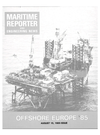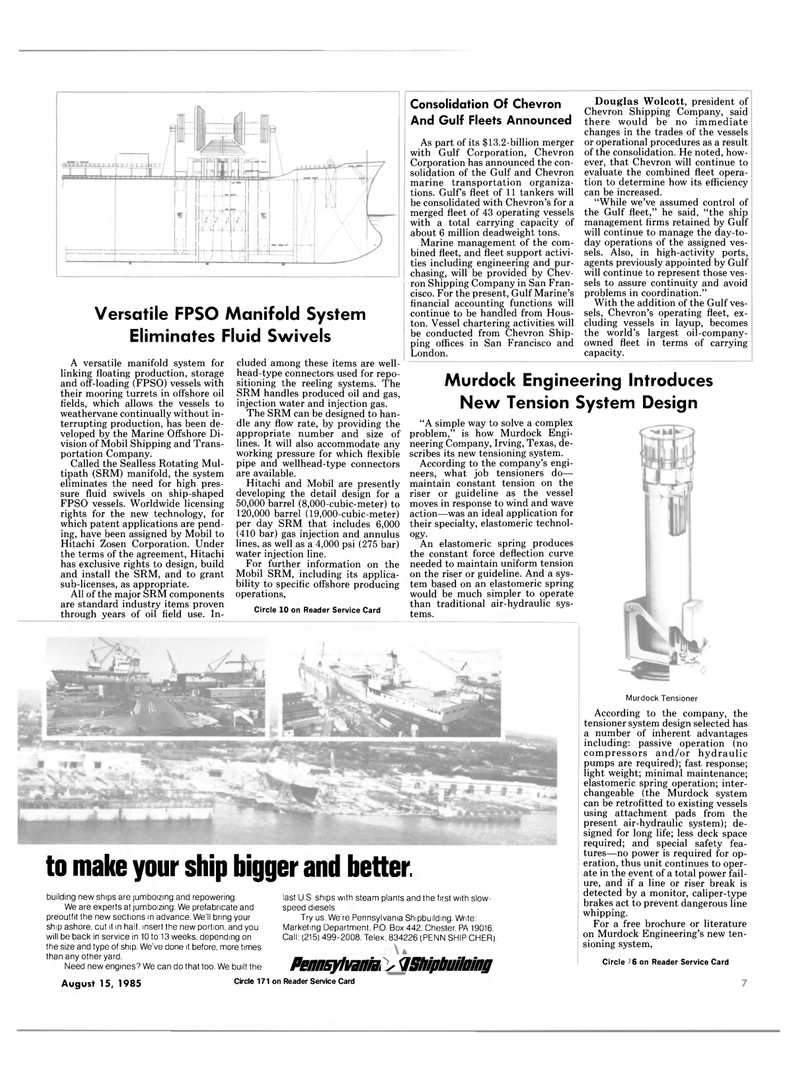
Page 5: of Maritime Reporter Magazine (August 15, 1985)
Read this page in Pdf, Flash or Html5 edition of August 15, 1985 Maritime Reporter Magazine
Versatile FPSO Manifold System
Eliminates Fluid Swivels
A versatile manifold system for linking floating production, storage and off-loading (FPSO) vessels with their mooring turrets in offshore oil fields, which allows the vessels to weathervane continually without in- terrupting production, has been de- veloped by the Marine Offshore Di- vision of Mobil Shipping and Trans- portation Company.
Called the Sealless Rotating Mul- tipath (SRM) manifold, the system eliminates the need for high pres- sure fluid swivels on ship-shaped
FPSO vessels. Worldwide licensing rights for the new technology, for which patent applications are pend- ing, have been assigned by Mobil to
Hitachi Zosen Corporation. Under the terms of the agreement, Hitachi has exclusive rights to design, build and install the SRM, and to grant sub-licenses, as appropriate.
All of the major SRM components are standard industry items proven through years of oil field use. In- cluded among these items are well- head-type connectors used for repo- sitioning the reeling systems. The
SRM handles produced oil and gas, injection water and injection gas.
The SRM can be designed to han- dle any flow rate, by providing the appropriate number and size of lines. It will also accommodate any working pressure for which flexible pipe and wellhead-type connectors are available.
Hitachi and Mobil are presently developing the detail design for a 50,000 barrel (8,000-cubic-meter) to 120,000 barrel (19,000-cubic-meter) per day SRM that includes 6,000 (410 bar) gas injection and annulus lines, as well as a 4,000 psi (275 bar) water injection line.
For further information on the
Mobil SRM, including its applica- bility to specific offshore producing operations,
Circle 10 on Reader Service Card to make your ship bigger and better. building new ships are jumboizing and repowering.
We are experts at jumboizing. We prefabricate and preoutfit the new sections in advance. We'll bring your ship ashore, cut it in half, insert the new portion, and you will be back in service in 10 to 13 weeks, depending on the size and type of ship. We've done it before, more times than any other yard.
Need new engines? We can do that too. We built the
August 15, 1985 Circle 171 last U.S. ships with steam plants and the first with slow- speed diesels
Try us. We're Pennsylvania Shipbuilding. Write:
Marketing Department, P.O. Box 442. Chester. PA 19016.
Call: (215) 499-2008. Telex 834226 (PENN SHIP CHER),
Pennsylvania Shipbuilding on Reader Service Card
Murdock Tensioner
According to the company, the tensioner system design selected has a number of inherent advantages including: passive operation (no compressors and/or hydraulic pumps are required); fast response; light weight; minimal maintenance; elastomeric spring operation; inter- changeable (the Murdock system can be retrofitted to existing vessels using attachment pads from the present air-hydraulic system); de- signed for long life; less deck space required; and special safety fea- tures—no power is required for op- eration, thus unit continues to oper- ate in the event of a total power fail- ure, and if a line or riser break is detected by a monitor, caliper-type brakes act to prevent dangerous line whipping.
For a free brochure or literature on Murdock Engineering's new ten- sioning system,
Circle 106 on Reader Service Card
Consolidation Of Chevron
And Gulf Fleets Announced
As part of its $13.2-billion merger with Gulf Corporation, Chevron
Corporation has announced the con- solidation of the Gulf and Chevron marine transportation organiza- tions. Gulf's fleet of 11 tankers will be consolidated with Chevron's for a merged fleet of 43 operating vessels with a total carrying capacity of about 6 million deadweight tons.
Marine management of the com- bined fleet, and fleet support activi- ties including engineering and pur- chasing, will be provided by Chev- ron Shipping Company in San Fran- cisco. For the present, Gulf Marine's financial accounting functions will continue to be handled from Hous- ton. Vessel chartering activities will be conducted from Chevron Ship- ping offices in San Francisco and
London.
Douglas Wolcott, president of
Chevron Shipping Company, said there would be no immediate changes in the trades of the vessels or operational procedures as a result of the consolidation. He noted, how- ever, that Chevron will continue to evaluate the combined fleet opera- tion to determine how its efficiency can be increased. "While we've assumed control of the Gulf fleet," he said, "the ship management firms retained by Gulf will continue to manage the day-to- day operations of the assigned ves- sels. Also, in high-activity ports, agents previously appointed by Gulf will continue to represent those ves- sels to assure continuity and avoid problems in coordination."
With the addition of the Gulf ves- sels, Chevron's operating fleet, ex- cluding vessels in layup, becomes the world's largest oil-company- owned fleet in terms of carrying capacity.
Murdock Engineering Introduces
New Tension System Design "A simple way to solve a complex problem," is how Murdock Engi- neering Company, Irving, Texas, de- scribes its new tensioning system.
According to the company's engi- neers, what job tensioners do— maintain constant tension on the riser or guideline as the vessel moves in response to wind and wave action—was an ideal application for their specialty, elastomeric technol- ogy.
An elastomeric spring produces the constant force deflection curve needed to maintain uniform tension on the riser or guideline. And a sys- tem based on an elastomeric spring would be much simpler to operate than traditional air-hydraulic sys- tems.

 4
4

 6
6
